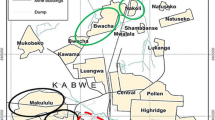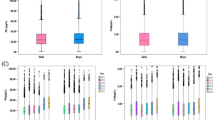Abstract
Extensive e-waste recycling activity in Guiyu, China, has been conducted using primitive techniques for the last 20 years, resulting in serious heavy metal environmental contamination. A polymorphic variant of the δ-aminolevulinic acid dehydratase (ALAD) gene has been found to influence lead uptake and, thus, may influence an individual’s susceptibility to lead toxicity. We therefore explored whether the ALAD gene polymorphism affects blood lead levels of newborns and children in Guiyu. A total of 273 newborns and 504 children, and a combination of 2004/2005 and 2006 independent recruitments were used for this study. Umbilical cord blood from newborns (Guiyu/exposed group 189 vs. Chaonan/reference group 84) and venous blood from children (exposed group, 319 vs. Chendian/reference group 185) were collected. Blood lead levels (BLLs) were measured via graphite furnace atomic absorption spectrometry (GFAAS) for all samples, while ALAD genotyping was performed using PCR-RFLP for 273 neonate cord blood and 246 children’s blood. The median BBLs of neonates in exposed group vs. the reference group were 10.50 (2.36–40.78) vs. 7.79 (0.8–19.51) for 2004/2005 and 9.41 (9.28–47.60) vs. 5.49 (0.35–18.68) for 2006, while child mean BLLs were 15.31 ± 5.79 vs. 9.94 ± 4.05 for 2004/2005 and 13.17 ± 5.98 vs. 10.04 ± 4.85 for 2006. The genotype frequencies in newborns were 98.90 % for the ALAD-1/ALAD-1 homozygote and 1.10 % for the ALAD-1/ALAD-2 heterozygotes, while the values were 95.93 and 4.07 %, respectively, in children. The allele frequencies of the ALAD-1 and ALAD-2 were 99.45 and 0.55 % for newborns, but 97.97 and 2.03 % for children, respectively. No significant differences in blood lead levels were found between ALAD-1/ALAD-1 and ALAD-1/ALAD-2 either in newborns or in children. The frequency distribution of the ALAD-2 allele in newborns from the exposed group was lower than that of the reference group. There were no significant differences, between the two different ALAD genotypes in the lead load of newborns and children. The frequency distribution of ALAD gene does not influence the blood lead levels of newborns and children in this case, which means that the higher lead burden in the exposed children was possibly influenced by e-waste recycling, but not ALAD genotypes.



Similar content being viewed by others
References
Ahamed M, Siddiqui MK (2007) Environmental lead toxicity and nutritional factors. Clin Nutr 26:400–408
Aseervatham GSB, Sivasudha T, Jeyadevi R, Ananth DA (2013) Environmental factors and unhealthy lifestyle influence oxidative stress in humans—an overview. Environ Sci Pollut Res 20:4356–4369
Bi X, Thomas GO, Jones KC, Qu W, Sheng G, Martin FL, Fu J (2007) Exposure of electronics dismantling workers to polybrominated diphenyl ethers, polychlorinated biphenyls, and organochlorine pesticides in South China. Environ Sci Technol 41:5647–5653
Deng WJ, Louie PKK, Liu WK, Bi XH, Fu JM, Wong MH (2006) Atmospheric levels and cytotoxicity of PAHs and heavy metals in TSP and PM 2.5 at an electronic waste recycling site in southeast China. Atmos Environ 40:6945–6955
Fowler BA (1993) Measuring lead exposure in infants, children, and other sensitive populations. National Academy, New York
Gao A, Lu XT, Li QY, Tian L (2010) Effect of the delta-aminolevulinic acid dehydratase gene polymorphism on renal and neurobehavioral function in workers exposed to lead in China. Sci Total Environ 408:4052–4055
Garcia-Leston J, Roma-Torres J, Vilares M, Pinto R, Prista J, Teixeira JP, Mayan O, Conde J, Pingarilho M, Gaspar JF, Pásaro E, Méndez J, Laffon B (2012) Genotoxic effects of occupational exposure to lead and influence of polymorphisms in genes involved in lead toxicokinetics and in DNA repair. Environ Int 43:29–36
Gonick HC (2011) Lead-binding proteins: a review. J Toxicol 2011: ID 686050. doi:10.1155/2011/686050
Goyer RA (1990) Transplacental transport of lead. Environ Health Perspect 89:101–105
Guo Y, Huo X, Li Y, Wu K, Liu J, Huang J, Zheng G, Xiao Q, Yang H, Wang Y, Chen A, Xu X (2010) Monitoring of lead, cadmium, chromium and nickel in placenta from an e-waste recycling town in China. Sci Total Environ 408(16):3113–3117
Hu H, Shih R, Rothenberg S, Schwartz BS (2007) The epidemiology of lead toxicity in adults: measuring dose and consideration of other methodologic issues. Environ Health Perspect 115:455–462
Huo X, Peng L, Xu X, Zheng L, Qiu B, Qi Z, Zhang B, Han D, Piao Z (2007) Elevated blood lead levels of children in Guiyu, an electronic waste recycling town in China. Environ Health Perspect 115:1113–1117
Kelada SN, Shelton E, Kaufmann RB, Khoury MJ (2001) Delta-aminolevulinic acid dehydratase genotype and lead toxicity: a HuGE review. Am J Epidemiol 154:1–13
Koreckova-Sysalova J (1997) Determination of cadmium and lead levels in human blood of a general Czech population by GFAAS. Biol Trace Elem Res 56:321–329
Leung AO, Duzgoren-Aydin NS, Cheung KC, Wong MH (2008) Heavy metals concentrations of surface dust from e-waste recycling and its human health implications in southeast China. Environ Sci Technol 42:2674–2680
Li H, Yu L, Sheng G, Fu J, Peng P (2007) Severe PCDD/F and PBDD/F pollution in air around an electronic waste dismantling area in China. Environ Sci Technol 41:5641–5646
Li Y, Xu X, Liu J, Wu K, Gu C, Shao G, Chen SJ, Chen GJ, Huo X (2008a) The hazard of chromium exposure to neonates in Guiyu of China. Sci Total Environ 403:99–104
Li Y, Xu XJ, Liu JX, Zheng LK, Chen GJ, Chen SJ, Huo X (2008b) Determination of meconium lead level of newborn by graphite furnace atomic absorption spectrometry. Spectrosc Spec Anal 28(2):447–449
Liu J, Xu X, Wu K, Piao Z, Huang J, Guo Y, Li WQ, Zhang YL, Chen AM, Huo X (2011) Association between lead exposure from electronic waste recycling and child temperament alterations. Neurotoxicology 32(4):458–464
Liu L, Xu X, Yekeen TA, Lin K, Li W, Huo X (2014) Assessment of association between the dopamine D2 receptor (DRD2) polymorphism and neurodevelopment of children exposed to lead. Environ Sci Pollut Res. doi:10.1007/s11356-014-2565-
Lu J, Lu X, Cui T, Xie G, Wu R, Zhang C, He X (2002) The polymorphism of delta-aminolevulinic acid dehydratase and genetic susceptibility to lead toxicity in Uighur and Yi population in China. J Ind Hyg Oecup Dis 20(1):277–281
Menke A, Muntner P, Batuman V, Silbergeld EK, Guallar E (2006) Blood lead below 0.48 micromol/L (10 microg/dL) and mortality among US adults. Circulation 114:1388–1394
Montenegro MF, Barbosa F Jr, Sandrim VC, Gerlach RF, Tanus-Santos JE (2006) Ethnicity affects the distribution of delta-aminolevulinic acid dehydratase (ALAD) genetic variants. Clin Chim Acta 367:192–195
National Center for Environmental Health (2013) Standard surveillance definitions and classifications.Centers for Disease Control and Prevention. Accessed 6 Jan 2014 http://www.cdc.gov/nceh/lead/data/definitions.htm
Qiu B, Peng L, Xu X, Lin X, Hong J, Huo X (2004) Medical investigation of e-waste demanufacturing industry in Guiyu town. In: Proceedings of the international conference on electronic waste and extended producer responsibility. Greenpeace and Chinese Society for Environmental Sciences, Beijing, China. pp. 79–83
Raczek E (1994) Polymorphism of delta-aminolevulinate dehydratase in the upper Silesian population, Poland. Hum Hered 44:172–174
Samarasekera U (2005) Electrical recycling exposes workers to toxic chemicals. Lancet 366:1913–1914
Schwartz BS, Lee BK, Stewart W, Ahn KD, Springer K, Kelsey K (1995) Associations of delta-aminolevulinic acid dehydratase genotype with plant, exposure duration, and blood lead and zinc protoporphyrin levels in Korean lead workers. Am J Epidemiol 142:738–745
Sobin C, Parisi N, Schaub T, Gutierrez M, Ortega AX (2011) delta-Aminolevulinic acid dehydratase single nucleotide polymorphism 2 and peptide transporter 2*2 haplotype may differentially mediate lead exposure in male children. Arch Environ Contam Toxicol 61:521–529
Telisman S, Colak B, Pizent A, Jurasovic J, Cvitkovic P (2007) Reproductive toxicity of low-level lead exposure in men. Environ Res 105:256–266
van Bemmel DM, Li Y, McLean J, Chang MH, Dowling NF, Graubard B, Rajaraman P (2011) Blood lead levels, ALAD gene polymorphisms, and mortality. Epidemiology 22:273–278
Wang JP, Guo XK (2006) Impact of electronic wastes recycling on environmental quality. Biomed Environ Sci 19:137–142
Wetmur JG, Bishop DF, Cantelmo C, Desnick RJ (1986) Human delta-aminolevulinate dehydratase: nucleotide sequence of a full-length cDNA clone. Proc Natl Acad Sci U S A 83:7703–7707
Wetmur JG, Kaya AH, Plewinska M, Desnick RJ (1991a) Molecular characterization of the human delta-aminolevulinate dehydratase 2 (ALAD2) allele: implications for molecular screening of individuals for genetic susceptibility to lead poisoning. Am J Hum Genet 49:757–763
Wetmur JG, Lehnert G, Desnick RJ (1991b) The delta-aminolevulinate dehydratase polymorphism: higher blood lead levels in lead workers and environmentally exposed children with the 1–2 and 2–2 isozymes. Environ Res 56:109–119
Wong CS, Duzgoren-Aydin NS, Aydin A, Wong MH (2007a) Evidence of excessive releases of metals from primitive e-waste processing in Guiyu, China. Environ Pollut 148:62–72
Wong CS, Wu SC, Duzgoren-Aydin NS, Aydin A, Wong MH (2007b) Trace metal contamination of sediments in an e-waste processing village in China. Environ Pollut 145:434–442
Wong MH, Wu SC, Deng WJ, Yu XZ, Luo Q, Leung AO, Wong CS, Luksemburg WJ, Wong AS (2007c) Export of toxic chemicals—a review of the case of uncontrolled electronic-waste recycling. Environ Pollut 149(2):131–140
Wu K, Xu X, Liu J, Guo Y, Li Y, Huo X (2010) Polybrominated diphenyl ethers in umbilical cord blood and relevant factors in neonates from Guiyu, China. Environ Sci Technol 44:813–819
Xu X, Yang H, Chen A, Zhou Y, Wu K, Liu J, Zhang Y, Huo X (2012) Birth outcomes related to informal e-waste recycling in Guiyu, China. Reprod Toxicol 33:94–98
Yakub M, Iqbal MP (2010) Association of blood lead (Pb) and plasma homocysteine: a cross sectional survey in Karachi, Pakistan. PLoS ONE 5(7):e11706. doi:10.1371/journal.pone.0011706
Yang H, Huo X, Yekeen TA, Zheng Q, Zheng M, Xu X (2013) Effects of lead and cadmium exposure from electronic waste on child physical growth. Environ Sci Pollut Res 20:4441–4447
Zhao Y, Wang L, Shen HB, Wang ZX, Wei QY, Chen F (2007) Association between delta-aminolevulinic acid dehydratase (ALAD) polymorphism and blood lead levels: a meta-regression analysis. J Toxicol Environ Health A 70:1986–1994
Zheng G, Xu X, Li B, Wu K, Yekeen TA, Huo X (2013) Association between lung function in school children and exposure to three transition metals from an e-waste recycling area. J Expo Sci Environ Epidemiol 23:67–72
Zheng L, Wu K, Li Y, Qi Z, Han D, Zhang B, Gu CW, Chen GJ, Liu JX, Chen SJ, Xu XJ, Huo X (2008) Blood lead and cadmium levels and relevant factors among children from an e-waste recycling town in China. Environ Res 108:15–20
Zheng Y, Song W, Wang Y (2001) The gene polymorphism of delta-aminolevulinate dehydratase (ALAD) in 530 cases of Chinese Han population. Chin J Prev Med 35(1):16–18
Zhu Z, Han Z, Bi X, Yang W (2012) The relationship between magnetic parameters and heavy metal contents of indoor dust in e-waste recycling impacted area, Southeast China. Sci Total Environ 433:302–308
Acknowledgments
This work was supported by the National Natural Science Foundation of China (21177080) and Guangdong University Project for International Cooperation and Innovation Platform (2013gjhz0007). We wish to thank Dr. Stanley Li Lin for his constructive comments.
Conflict of interest
The authors declare that there are no conflicts of interest.
Author information
Authors and Affiliations
Corresponding author
Additional information
Responsible editor: Philippe Garrigues
Rights and permissions
About this article
Cite this article
Huo, X., Peng, L., Qiu, B. et al. ALAD genotypes and blood lead levels of neonates and children from e-waste exposure in Guiyu, China. Environ Sci Pollut Res 21, 6744–6750 (2014). https://doi.org/10.1007/s11356-014-2596-2
Received:
Accepted:
Published:
Issue Date:
DOI: https://doi.org/10.1007/s11356-014-2596-2




